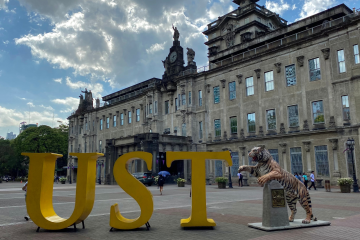
THE FACULTY of Arts and Letters Student Council (ABSC) has launched a survey on redesigning the Artlets type A uniform, citing calls to make it more “inclusive” and aligned with “progressive” ideals.
“As one of the oldest faculties at the University, we recognize the urgency to bring our uniform in line with contemporary standards and progressive ideals, addressing these concerns in a timely and meaningful manner,” he added.
The type A uniform for male Artlets is a white pleated polo barong paired with black pants, while female Artlets wear a white blouse with the iconic lambda and a pleated blue skirt. The ten pleats in the polo barong symbolize the number of programs AB offered during the time it was designed. The lambda, designed by the late AB dean Prof. Magdalena Alonso-Villaba in the 1960s, symbolizes “letters” as a nod to the faculty name.
Santiago claimed that many Artlets alumni and students have expressed dissatisfaction with the design, citing the constant comparison of the type A uniform’s features with those of a high school uniform.
‘Restrictive regulations’
Some students have expressed their concerns over the University’s policies which they claimed to bear restrictions on their freedom of expression.
According to Santiago, Artlets who belong to the LGBTQIA+ community have been calling for an “inclusive” and “gender-neutral uniform” for years due to the prohibition against cross-dressing.
Under the revised 2018 UST student handbook’s code of conduct, students may only cross-dress for authorized activities such as participating in a play.
“Cross-dressing or wearing the clothes of the opposite sex is prohibited unless otherwise authorized for legitimate purpose,” no. 4, letter b of Policies, Procedures, and Standards, No. 1027 reads.
“We hope that by doing so (re-evaluating the uniform policy via survey), we can revamp our uniform, making it more contemporary, representative, and inclusive of the ideals held by our student body,” the ABSC president said.
Communication freshman Julianne Palomares believes students should be allowed to wear their preferred uniforms.
“They (administrative officials) shouldn’t limit the students in wearing [just] the Type A uniform. Somehow, the Type B [uniform] helps us express ourselves more and also is more comfortable and warmer to wear,” she said.
The Type B uniform, which consists of a polo shirt embroidered with the faculty logo, is only worn as students’ everyday uniform after Ash Wednesday until the end of the summer period, according to the June 2014 resolution of the Council of Regents. Full implementation of the AB uniform policy, which required all Artlets to wear Type A uniforms during onsite classes in the St. Raymund Peñafort and Buenaventura G. Paredes O.P. buildings, began last Oct. 2.
Joseph Mirabete, an English language studies sophomore, hopes the administration will provide more leeway in allowing students to express themselves through changes to the uniform policy. He added that altering AB’s type A uniform to fit modern aesthetics would allow the Artlets to “gain more respect” from other colleges and faculties.
“We look a lot like grade schoolers. We don’t define UST or even the branch. We look childish or unprofessional. An AB student should look professional and powerful, as we wield courses under writing, law and liberal arts,” Mirabete said.
Historical significance
For fourth-year journalism student Joseph Ong Moscoso, wearing the present AB uniform fosters a connection with the alumni of the faculty.
“Whenever old Thomasians would see me…they would recognize my uniform and I feel a sort of [historical connection] with them because they were once in my position,” he said.
AB instructor Melanie Magpantay said while the poll is an avenue for students to help in improving the appearance of their uniform, such changes could alter its historical significance.
“The term ‘inclusivity’ is a double-edged sword. By including all stakeholders of the AB [c]ommunity in the uniform consultation, there will be an inevitable change in [the] appearance of the uniform, however small it may be,” she said.
Magpantay views the AB administration’s implementation of the uniform policy as “not too strict,” citing other universities that refuse entry to students who do not comply with their dress code.
“But these prescriptions on shoes, socks, blouse, and barong are preparations for the students on how they should carry themselves as adults because, in the world of work, appearances matter,” she added.
The instructor said members of the Artlets community have the right to interpret their own identity but should consider a balance of changes in the Type A uniform.
“The question is, ‘Where is the middle ground where the administrators can include those who feel excluded while preserving the memory attached to the current uniform and adhering to the Artlet Catholic identity?’,” Magpantay said.
The last major modification to the AB uniform was in 2002, which involved adding four pleats to the male uniform’s six-pleated polo as well as reducing the pleats of the female Artlets’ skirts from five to two.
Santiago said the council seeks to initiate the uniform change that would reflect the approved suggestions of the Artlets next year. It aims to implement the modifications the following year.
Aside from revamping the type A uniform, he said ABSC has plans to address students’ concerns over the type B uniform. He revealed that the council has submitted a petition to the dean’s office to allow students to pair the type B uniform with shorts.
The survey, which will run until the end of November, aims to achieve a participation rate of at least 70%. As of August 2023, the UST Faculty of Arts and Letters has 3,600 enrollees. F – Aljon Danniell Eguia and Trisha Tamio




[…] READ: ABSC launches poll on changing the Artlets’ type A uniform […]